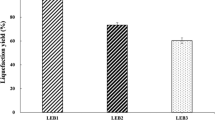Abstract
In this work, bio-inspired concepts, including a Self-Healing (SH) and super hydrophobic structure, were used to produce slow-release of urea fertilizer. Following a bottom-up process, an SH layer on the urea granule was produced from a combination of two natural waxes, palm and carnauba, and fabricated by a hot-melt coating process in a pan coater. Another layer for super hydrophobicity was formed by a deposition of submicron-wax and carbon black particles on the SH layer to create a micro-nanostructure during coating. After the heat treatment, a smooth coating and even deposition of waxes throughout the urea surfaces were obtained. The properties of the waxes, a healing mechanism, and releasing profiles were examined using an optical microscope. After cracking of the coated urea surface, the intrinsic self-healing behavior was stimulated by heating the samples above 45 °C, corresponding to high ambient daytime temperatures. Air-trapping behavior was observed at the interphase of the water and coated urea, creating super hydrophobic granule surfaces which act as an invisible layer for water-penetration protection. The releasing profiles of the coated urea in soil revealed that the releasing periods could be significantly extended to four-times longer than those of the uncoated urea.
Similar content being viewed by others
References
Azeem B, KuShaari K, Man Z B, Basit A, Thanh T H. Review on materials & methods to produce controlled release coated urea fertilizer. Journal of Controlled Release, 2014, 181, 11–21.
Kiran J K, Khanif Y M, Amminuddin H, Anuar A R. Effects of controlled release urea on the yield and nitrogen nutrition of flooded rice. Communications in Soil Science and Plant Analysis, 2010, 41, 811–819.
Bozzelli A J, Belak S G, Campbell R H. Slow Release Fertilizer Comprising a Dispersion of Urea-wax Adduct in Wax, and Method of Making, US patent 3300293A, 1967.
Melchiore J J, Mccorquodale J W E. Process for Slow Release Fertilizers Comprising Urea, Paraffin Wax and Adduct-inhibiting Chlorinated Wax, US patent 3290138A, 1966.
Hashimoto I, Mullins R C. Dissolution of sulfur-coated urea in soil: I. Wax-sealed sulfur-coated urea. Soil Science Society of America Journal, 1979, 43, 1165–1168.
Hudson A P, Woodward F E. Non-blocking Wax Sealants for Fertilizers, US patent 5423897A, 1995.
Hargrove G L, Maruvada S, Wilson R S, Wynnyk N P, Xing B. Cross-linked Modified Waxes for Controlled Release Fertilizers, US patent 20120111075A1, 2012.
Carbone G, Mangialardi L. Hydrophobic properties of a wavy rough substrate. European Physical Journal E, 2005, 16, 67–76.
Simpson J T, Hunter S R, Aytug T. Superhydrophobic materials and coatings: A review. Reports on Progress in Physics, 2015, 78, 086501.
Yohe S T, Colson Y L, Grinstaff M W. Superhydrophobic materials for tunable drug release: Using displacement of air to control delivery rates. Journal of the American Chemical Society, 2012, 134, 2016–2019.
Xue C H, Jia S T, Zhang J, Ma J Z. Large-area fabrication of superhydrophobic surfaces for practical applications: An overview. Science and Technology of Advanced Materials, 2010, 11, 033002.
Milionis A, Sharma C S, Hopf R, Uggowitzer M, Bayer I S, Poulikakos D. Engineering fully organic and biodegradable superhydrophobic materials. Advanced Materials Interfaces, 2019, 6, 1801202.
Morrissette J M, Carroll P J, Bayer I S, Qin J, Waldroup D, Megaridis C M. A methodology to produce eco-friendly superhydrophobic coatings produced from all-water-processed plant-based filler materials. Green Chemistry, 2018, 20, 5169–5178.
Wang W, Lockwood K, Boyd L M, Davidson M D, Movafaghi S, Vahabi H, Khetani S R, Kota A K. Superhydrophobic coatings with edible materials. ACS Applied Materials & Interfaces, 2016, 8, 18664–18668.
Zhang W W, Lu P, Qian L Y, Xiao H N. Fabrication of superhydrophobic paper surface via wax a mixture coating. Chemical Engineering Journal, 2014, 250, 431–436.
Wu D Y, Meure S, Solomon D. Self-healing polymeric materials: A review of recent developments. Progress in Polymer Science, 2008, 33, 479–522.
Kim Y H, Wool R P. A theory of healing at a polymer-polymer interface. Macromolecules, 1983, 16, 1115–1120
Ho J S, Lin C B, Chang Z C. The effect of crack orientation on methanol-induced crack healing in poly(methyl methacrylate). Tamkang Journal of Science and Engineering, 2007, 10, 369–378.
Wool R P, O’Connor K M. A theory crack healing in polymers. Journal of Applied Physics, 1981, 52, 5953–5963.
Buchwald R, Breed M D, Greenberg A R. The thermal properties of beeswaxes: Unexpected findings. Journal of Experimental Biology, 2008, 211, 121–127.
Buchwald R, Breed M D, Bjostad L, Hibbard B E, Greenberg A R. The role of fatty acids in the mechanical properties of beeswax. Apidologie, 2009, 40, 585–594.
Zhang R G, Zheng H, Zhang H, Feng Y, Li K, Zhang W W. Thermal analysis of four insect waxes based on differential scanning calorimetry (DSC). Procedia Engineering, 2011, 18, 101–106.
Hussain I, Mahmood Z, Yasmeen R, Jahangir M, Hammed R, Nasir R. Assay of urea with p-dimethylaminobenzaldehyde. Journal of the Chemical Society of Pakistan, 2002, 24, 122–129.
Bhushan B, Jung Y C. Micro- and nanoscale characterization of hydrophobic and hydrophilic leaf surfaces. Nano-technology, 2006, 17, 2758–2772.
Acknowledgment
We gratefully acknowledge the financial support from National Nanotechnology Center (NANOTEC), a member of National Science and Technology Development, Thailand.
Author information
Authors and Affiliations
Corresponding author
Supplementary file
Rights and permissions
About this article
Cite this article
Charoenchai, M., Prompinit, P., Kangwansupamonkon, W. et al. Bio-inspired Surface Structure for Slow-release of Urea Fertilizer. J Bionic Eng 17, 335–344 (2020). https://doi.org/10.1007/s42235-020-0027-2
Published:
Issue Date:
DOI: https://doi.org/10.1007/s42235-020-0027-2




